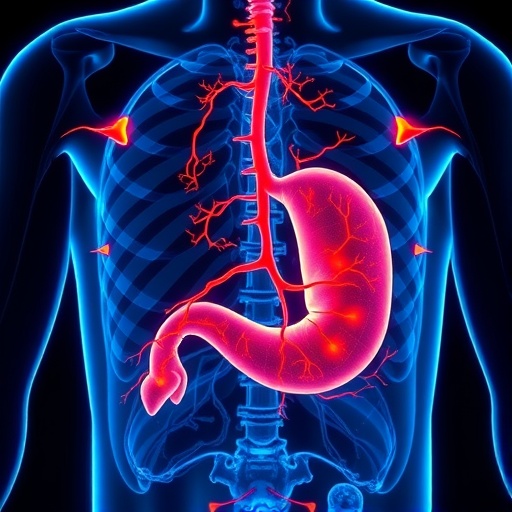Gastric cancer continues to present a formidable challenge to global health, compelling researchers to delve deeper into its underlying mechanisms and potential prognostic markers. A groundbreaking study recently published in BMC Cancer introduces a novel nerve-related prognostic model that harnesses the power of both bulk and single-cell RNA sequencing data, offering new insights into tumor dynamics and patient survival. This innovative approach underscores the crucial role that neural components play within the tumor microenvironment, a facet that has remained largely uncharted until now.
The impetus for this research stems from mounting evidence that neural activity significantly influences tumor progression and behavior. Although previous studies have hinted at the interaction between nerves and cancer cells, the clinical implications of nerve-related genes (NRGs) in gastric cancer have not been clearly elucidated. By integrating cutting-edge sequencing technologies, the authors sought to bridge this crucial knowledge gap and establish reliable prognostic indicators.
Central to the study was the collection of gastric cancer tissue and matched adjacent normal samples from eight patients. These samples provided a rich substrate for single-cell RNA sequencing, enabling a high-resolution view of gene expression at the cellular level. Complementing this experimental data, extensive gene expression profiles and patient outcomes were mined from The Cancer Genome Atlas (TCGA) and Gene Expression Omnibus (GEO) repositories, providing a robust foundation for analytical precision and model validation.
In total, the researchers identified and curated 441 nerve-related genes from the KEGG database, which served as the initial pool for their prognostic model. Through rigorous statistical techniques, specifically LASSO regression analysis, the team distilled this expansive list to eight key genes that exhibited a significant correlation with overall survival in gastric cancer patients. This parsimonious yet potent gene signature formed the backbone of the so-called nerve-related risk score (NRRS).
The prognostic power of the NRRS was striking. Patients classified into the low-risk category demonstrated markedly prolonged overall survival compared to their high-risk counterparts. This distinction not only highlights the prognostic value of nerve-related gene expression patterns but also proposes a novel biomarker framework that oncologists may utilize for risk stratification in clinical settings.
Delving deeper, the study explored how disparate NRRS subtypes corresponded with genomic alterations and immune landscape variations within tumors. High NRRS patients exhibited a richer infiltration of immune cells and heightened expression of immune checkpoint molecules, indicating an intricate interplay between neural gene signatures and the tumor immune microenvironment. Such findings could have profound implications for tailoring immunotherapy regimens based on nerve-related molecular phenotypes.
A particularly illuminating element of the research was the single-cell RNA-seq analysis of over 55,000 cells derived from gastric cancer tissues. Mapping the expression of the NRRS genes across different cell populations revealed intriguing cellular specificity. For example, EPHB3 and LPAR2 were predominantly expressed in epithelial cells, while NRP1, GNAI1, and SEMA6A were enriched within endothelial cells. These spatial expression patterns may shed light on the cellular crosstalk mechanisms facilitated by nerve-related pathways during tumorigenesis.
The identification of NRG expression profiles within the tumor microenvironment creates a compelling narrative linking nerve signaling with cancer biology. It suggests that neural components are not merely passive bystanders but active participants in shaping the disease course. This paradigm shift opens avenues for exploring neuro-modulatory interventions alongside established chemotherapy and immunotherapy protocols.
Moreover, the integration of bulk and single-cell sequencing data exemplifies a sophisticated methodological framework that enhances the granularity and interpretability of genomic analyses. Such comprehensive data fusion amplifies confidence in the prognostic model’s applicability and underscores the future potential of multi-omics approaches in oncology research.
Crucially, the study’s findings offer a practical translational pathway. By leveraging the NRRS, clinicians may better identify gastric cancer patients who stand to benefit most from specific therapeutic strategies, potentially improving treatment outcomes and personalized care. It also prompts the consideration of nerve-related pathways as therapeutic targets themselves, a novel frontier warranting further experimental and clinical investigation.
The comprehensive characterization of the immune milieu relative to NRRS further enriches the model’s clinical relevance. Given the burgeoning success of immune checkpoint inhibitors in cancer therapy, recognizing how nerve-related gene expression influences immune cell infiltration and checkpoint marker expression could refine patient selection for immunotherapy, enhancing efficacy while mitigating unnecessary exposure.
In summary, this pioneering study represents a significant leap forward in cancer prognostication by highlighting nerve-related molecular dynamics within gastric cancer. The robust NRRS model stands as a testament to the power of contemporary sequencing technologies coupled with advanced bioinformatics, providing a definitive tool for survival prediction and therapeutic guidance.
As the landscape of cancer research evolves, integrating neural biology with tumor genomics heralds a new era of precision oncology. This nerve-centric lens not only enriches our understanding of tumor microenvironments but also catalyzes innovation in prognostic modeling and therapeutic targeting that may ultimately reshape clinical paradigms.
Future research endeavors building upon these findings will undoubtedly enhance our grasp of neural influences on cancer, potentially unraveling novel molecular targets and intervention strategies that improve patient prognosis across diverse cancer types.
Subject of Research: Development of a nerve-related prognostic model for gastric cancer based on bulk and single-cell RNA sequencing data
Article Title: Development and validation of a novel nerve-related prognostic model for gastric cancer based on bulk and single-cell RNA sequencing data
Article References: Qiu, L., Yao, S., Yang, Z. et al. Development and validation of a novel nerve-related prognostic model for gastric cancer based on bulk and single-cell RNA sequencing data. BMC Cancer 25, 1738 (2025). https://doi.org/10.1186/s12885-025-15202-9
Image Credits: Scienmag.com
DOI: 10 November 2025




